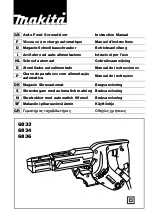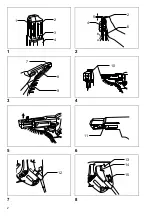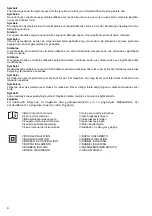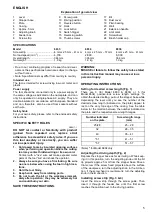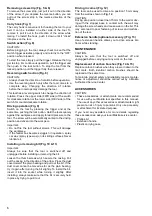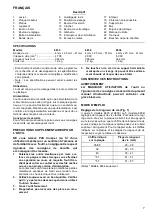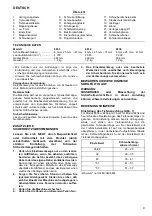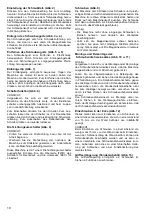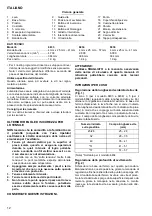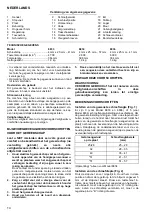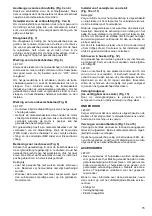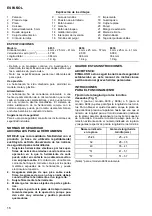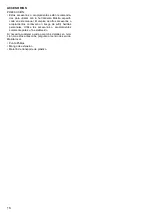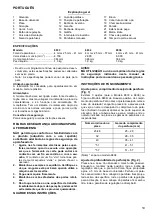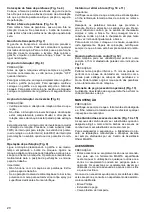
6
Removing screw strip (Fig. 5 & 6)
To remove the screw strip, just pull it out in the direction
of the arrow. If you depress the reverse button, you can
pull out the screw strip in the reverse direction of the
arrow.
Carry hook (Fig. 7)
The carry hook is convenient for hooking the tool to your
belt. It can be installed on either side of the tool. To
remove it, pull it out in the direction of the arrow while
raising. To install the hook, push it down until it “clicks”
into place on the tool.
Switch action (Fig. 8)
CAUTION:
Before plugging in the tool, always check to see that the
switch trigger actuates properly and returns to the “OFF”
position when released.
To start the tool, simply pull the trigger. Release the trig-
ger to stop. For continuous operation, pull the trigger and
then push in the lock button. To stop the tool from the
locked position, pull the trigger fully, then release it.
Reversing switch action (Fig. 8)
CAUTION:
• Always check the direction of rotation before operation.
• Use the reversing switch only after the tool comes to a
complete stop. Changing the direction of rotation
before the tool stops may damage the tool.
This tool has a reversing switch to change the direction of
rotation. Press the upper side (FWD side) of the switch
for clockwise rotation or the lower side (REV side) of the
switch for counterclockwise rotation.
Driving operation (Fig. 9)
Switch on the tool by pressing the trigger and at the
same time pushing the lock button. Hold the tool squarely
against the workpiece and apply forward pressure to the
tool. The screw will be automatically carried to the driving
position and driven into the workpiece.
Important:
• Do not fire the tool without screws. This will damage
the workpiece.
• If the feeder box becomes sluggish in operation, spray
car wax (spray type wax) on its sliding surfaces. Never
lubricate it.
Installing or removing bit (Fig. 10 & 11)
Important:
Always be sure that the tool is switched off and
unplugged before installing or removing the bit.
Loosen the thumb screws which secure the casing. Pull
out the casing in the direction of the arrow. Press the dust
cover toward the plain bearing and pull out the bit. If the
dust cover cannot be moved as far as the plain bearing,
try it again after turning the bit slightly. To install the bit,
insert it into the socket while turning it slightly. After
installing, always make sure that the bit is securely held
in place by trying to pull it out.
Driving in corner (Fig. 12)
This tool can be used to drive at a position 15 mm away
from the wall as shown in Fig. 12.
CAUTION:
Driving at a position closer than 15 mm to the wall or driv-
ing with the stopper base in contact with the wall may
damage the screw heads and cause wear on the bit. This
may also lead to poor fastening of screws and malfunc-
tion of the tool.
Extension handle (optional accessory) (Fig. 13)
Use of extension handle allows you to drive screws into
floors while standing.
MAINTENANCE
CAUTION:
Always be sure that the tool is switched off and
unplugged before carrying out any work on the tool.
Replacement of carbon brushes (Fig. 14 & 15)
Replace carbon brushes when they are worn down to the
limit mark. Both identical carbon brushes should be
replaced at the same time.
To maintain product safety and reliability, repairs, mainte-
nance or adjustment should be carried out by a Makita
Authorized Service Center.
ACCESSORIES
CAUTION:
• These accessories or attachments are recommended
for use with your Makita tool specified in this manual.
The use of any other accessories or attachments might
present a risk of injury to persons. Only use accessory
or attachment for its stated purpose.
If you need any assistance for more details regarding
these accessories, ask your local Makita service center.
• Phillips bit
• Extension handle
• Plastic carrying case

